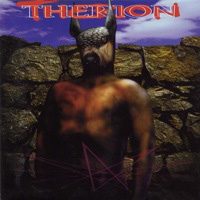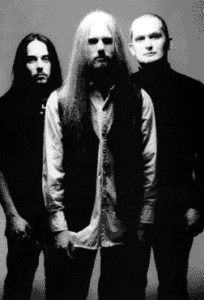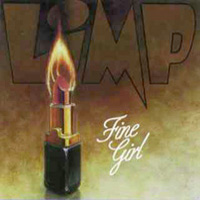 Therion
Therion
Theli (Nuclear Blast)
by Scott Hefflon
This takes the cake. The whole thing. In fact, there’s no one even close, so Therion can take the cake and eat it slowly, enjoying the solitude of having not a single competitor anywhere near. This is by far the most mind-blowing, genre-spanning release I’ve ever heard. Imagine if Danny Elfman would stop trying to outdo yuppie-boywonder Frank Lloyd Webber, and remember something called a guitar. Excuse me for being old fashioned, but there’s nothing like a guitar singing a bittersweet melody. Massive string sections flailing away madly, even when combined with layers of cleverly modulated synths and keyboards, all can benefit from the indistinguishable voice of a guitar. Especially a distorted guitar. Especially a very distorted, screaming from the high heavens on a seek and destroy mission guitar. And yet, both Webber and Elfman stick by their orchestrated guns, missing out entirely on the jet stream scream of distortion-soaked guitar. A pity, really.
Before I mislead you, dear reader, I must admit that the richly orchestrated Theli is the latest release from a band that has evolved from a genre called “death metal.” If a gloriously symphonic masterpiece which puts to shame the best horror soundtrack, perhaps even rubbing elbows with the finest musical scoring of our generation, sounds a bit too strenuous for you, then please, flip to another page. I believe there’s an interesting interview with the Offspring somewhere in which I was kind enough not to ask, “Hey, if you’re a punk band, why do you sound so much like Def Leppard?” For those of you who don’t mind, and perhaps even revel in, a “heavy metal”-ish sounding guitar used alongside choirs, a lonely piano, and a full-on orchestra, I’ve got a treat for you. In closing this introduction/disclaimer, I’d like to explain that Therion not only “pulls out all the stops” (an organist’s version of cranking an amp up to 11 and wailing away), they pull out the stops in every conceivable configuration. In order to review this, I may have to refer to some “obscure” bands and/or sounds to accurately describe what I hear. Please bear with me…
It begins with a low frequency sound. Not so much a note, just a sound. One low enough to barely hear. A sound more felt than heard. In fades a piano and some scary keyboards, and later a sci-fi synth like the ones used in Dr. Who or Star Trek. Eerie and other-worldly, and yes, intentionally kinda cheesy. Then in roll the timpanis, and the sound echoes off the cathedral rafters for a long moment. “To Mega Therion” explodes with staccato bursts of a shrill choir (either the North German radio choir or the Siren choir) like those used in “The Omen,” punctuated by the chu-chunk of very heavy metal, the sound of a shotgun being cocked. And then, as never before heard, a massive choir and orchestra jam with a galloping drum line and chugging guitar. When a hardcore voice roars a few words, don’t despair! Despite the Motörhead-meets-Earth-Crisis lapse, immediately following is a rich, mid-range male voice I can describe only as Queensrÿche-style layering. From there, the choirs and the guitars trade the spotlight and perform harmoniously, sweeping majestically all the while. A brief bout of solo trading takes place between a guitar and a keyboard, reminiscent of neo-classical guitar wanker, Yngwie J. Malmsteen. As I said, it’s brief. One particular movement features first a piano, and then a guitar, performing a rock classic, the “hammer-on.” Popularized by Eddie Van Halen, it’s rare to hear a grand piano having at it over a chord structure Vangelis might use in a Chariots of Fire beach scene. A rather rainy beach scene, tinkling pianos often inspire that sort of imagery.
 “Cults of the Shadows” begins with a rock bass, soon accompanied by the sort of keyboard you’d ordinarily expect to hear at a hockey game. But this zamboni accompanyist seems to be in a dark and haunting mood. While this alone should raise a few eyebrows, even more surprising is how well it works into the package of all the aforementioned sounds. Then toss in a cutesy keyboard whistling a chipper melody similar to “She-Bop” by Cyndi Lauper. Following is, oh, a bit of horror movie piano like Halloween, a quick harpsichord segment, and then the finale of everything at once. At this point in time, it’s recommended to press stop and stare dumbly at your CD player. We’re only on song three, and already I feel a fit of manic giggling coming over me.
“Cults of the Shadows” begins with a rock bass, soon accompanied by the sort of keyboard you’d ordinarily expect to hear at a hockey game. But this zamboni accompanyist seems to be in a dark and haunting mood. While this alone should raise a few eyebrows, even more surprising is how well it works into the package of all the aforementioned sounds. Then toss in a cutesy keyboard whistling a chipper melody similar to “She-Bop” by Cyndi Lauper. Following is, oh, a bit of horror movie piano like Halloween, a quick harpsichord segment, and then the finale of everything at once. At this point in time, it’s recommended to press stop and stare dumbly at your CD player. We’re only on song three, and already I feel a fit of manic giggling coming over me.
The intro to “In The Garden of Set” answers a long nagging question I’ve had: What’s a mandolin sound like through a phaser, a voice box, and a wah-wah? From there, the Egyptian motif carries through (I’m thinking Powerslave by Iron Maiden for no real reason), and the hardcore roar and Queensrÿchian harmonies stray dangerously close to powermetal-esque, barrel-chested emphatic vocals, but return to the now-familiar (yet no less disconcerting) blend of orchestration and metal. More piano-doing-guitar-tapping-solos, then the whole string section plays a guitar solo and the song ends. “Interludium” is a peaceful intermission, mixing military snare beats with a soothing, wordless choir. Blending into “Nightside of Eden,” the lyrics become a little more naggingly important. Written by Thomas Karlsson (vocalist of Goth metal band Tristitia and founder/spiritual leader of Swedish dark magik lodge, Dragon Rouge) this stuff may get a bit heavy for some listeners. I can deal with Dune-inspired nonsense like “He is the Kwizatz Haderach/ He is born of Caladan/ And will take the Gom Jabbar” from “To Tame a Land” by Iron Maiden, but the vibe alone is freaky enough for me. I don’t casually read aloud from Necronomicon, nor do I pore over lyrics by bands such as this. They aren’t kidding. If you think Tangerine Dream or Elfman soundtracks send shivers along your spine, try this. A bit of Fields of the Nephilim mix with melodic speedmetal, just to confuse the matter that much more. “Grand Finale/Postludium” is exactly what it sounds like; a combination of all the previously-used elements racing one after another in a melée of a medley, finally fading into a sinister lumbering into the foggy distance. The monster never died. A sequel is forthcoming.
You get the idea. Theli makes the chase scene through the hedge maze in The Shining feel like kid stuff. The visuals are internal – memories of your most terror-stricken moments, scenes from every horror you’ve ever seen, all washing over you as the songs mercilessly continue. Beautiful and horrifying.



